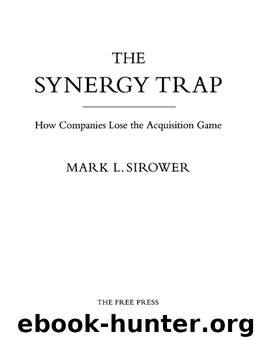THE SYNERGY TRAP by MARK L. SIROWER

Author:MARK L. SIROWER
Language: eng
Format: epub
Published: 1997-07-15T00:00:00+00:00
Problems in Post-Merger Integration
Another stream of research within the management literature attempts to explain what might be driving acquisition performance. Following the decision to pursue an acquisition as a strategic alternative, there are two distinct phases to the implementation process of the decision, or what I call the acquisition game: (1) top managements commitment of resources to make the acquisition and (2) post-merger management of projected synergies.
This literature focuses on identifying the process problems that may occur in the post-merger integration phase of mergers and takeovers that may prevent the realization of synergies (Shrivastava, 1986; Jemison and Sitkin, 1986a, 1986b; Dundas and Richardson, 1982; Buono and Bowditch, 1989; Napier, 1989; Nahavandi and Malekzadeh, 1988; Shanley and Correa, 1992; and reviewed in Ramanujam and Varadarajan, 1989, and Schweiger and Walsh, 1990). The focus is generally on finding the appropriate integration techniques (e.g., procedural, physical, and sociocultural) given the motives and characteristics and organizational cultures of the acquiring and acquired firms (Shrivastava, 1986). Haspeslagh and Jemison (1991) document an array of problems in both the acquisition decision and integration processes.
This literature is still in the theory-building stage, however, with little empirical evidence. What is generally ignored by these authors is the relationship between amount and timing of potential benefits from post-merger integration and the implicit necessary performance objectives that are created by managers when resources are allocated up front to execute a corporate strategy through acquisition. This literature has not yet offered models or even addressed exactly how much synergy or performance gains would be generated if the various process problems did not occur. This is the major void in the literature. Further, researchers have not yet offered testable propositions regarding the prediction of when problems are more likely to occur or how different managers across firms may react when these problems occur.
Jemison and Sitkin (1986a, 1986b) suggest that disappointing merger performance may result from not enough pre-merger attention given to post-merger integration planning issues because of the pressure to close deals quickly. These ideas were first discussed over twenty years earlier in Keil (1966) and reiterated by Leighton and Tod (1969). As Keil (1966:8) reports, “Most acquisitions are consummated too hastily. Then, too, there’s an overdependence on intuition. Another reason is that frequently the acquiring company doesn’t know enough about the potential of the company it is buying.”
So this is clearly not a recent issue or concern in the literature or in practice. Perhaps a greater problem is that the resource allocation (pricing) decision becomes completely detached from any synergies that may be realizable under any conditions, even if all post-merger management issues were thoroughly considered. It is now well known that realizing performance gains can actually take several years, and commonly touted operating synergies such as economies of scale can turn out to be extremely complex and difficult management tasks (Haspeslagh and Jemison, 1991; Kitching, 1967; Mueller, 1980; Finkelstein, 1986) exacerbated by conflict between the acquiring and acquired firm (Marks and Mirvis, 1985). Herein lies the synergy limitation view.
Download
This site does not store any files on its server. We only index and link to content provided by other sites. Please contact the content providers to delete copyright contents if any and email us, we'll remove relevant links or contents immediately.
Hit Refresh by Satya Nadella(9041)
The Compound Effect by Darren Hardy(8821)
Change Your Questions, Change Your Life by Marilee Adams(7641)
Nudge - Improving Decisions about Health, Wealth, and Happiness by Thaler Sunstein(7622)
The Black Swan by Nassim Nicholas Taleb(7016)
Deep Work by Cal Newport(6890)
Daring Greatly by Brene Brown(6451)
Rich Dad Poor Dad by Robert T. Kiyosaki(6414)
Principles: Life and Work by Ray Dalio(6233)
Playing to Win_ How Strategy Really Works by A.G. Lafley & Roger L. Martin(5941)
Man-made Catastrophes and Risk Information Concealment by Dmitry Chernov & Didier Sornette(5926)
Digital Minimalism by Cal Newport;(5670)
Big Magic: Creative Living Beyond Fear by Elizabeth Gilbert(5617)
The Myth of the Strong Leader by Archie Brown(5429)
The Slight Edge by Jeff Olson(5355)
Discipline Equals Freedom by Jocko Willink(5291)
The Motivation Myth by Jeff Haden(5158)
Stone's Rules by Roger Stone(5029)
The Laws of Human Nature by Robert Greene(5006)
